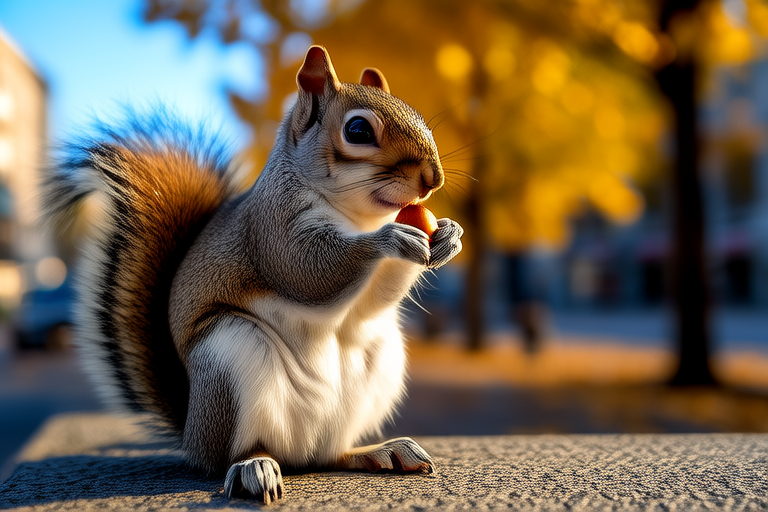Squirrels in the City: Surviving Urban Challenges with Ingenious Adaptability
In the bustling heart of many cities, there exists a resilient population of creatures that thrive amidst the concrete jungle. Squirrels, with their bushy tails and agile movements, have become a familiar sight in urban areas. These small mammals have adapted to city life in remarkable ways, showcasing a level of ingenuity that has allowed them to survive and even flourish in an environment far removed from their natural habitats.
The Urban Habitat: A New Frontier for Squirrels
Urbanization has transformed landscapes worldwide, leading to the loss of many traditional habitats for wildlife. However, some species, like squirrels, have managed to find new homes within the confines of cities. The urban landscape offers a variety of niches that squirrels can exploit, from parks and gardens to rooftops and alleyways. In cities, squirrels often choose areas with abundant trees and green spaces, which provide both shelter and food sources.
Scientific studies have shown that squirrels prefer areas with mature trees, as these offer better nesting sites and protection from predators. For example, in cities like New York and London, squirrels have been observed selecting parks and residential areas with large, established trees over barren or industrial zones. This preference for green spaces highlights the importance of maintaining urban greenery for the well-being of urban wildlife.
Dietary Adjustments: Nuts and Beyond
One of the most significant adaptations of urban squirrels is their ability to adjust their diets according to the available resources. While squirrels are known to be primarily herbivorous, feeding on nuts, seeds, fruits, and tree bark, city life has introduced them to a diverse range of supplementary foods. Many urban squirrels have become adept at scavenging for human-provided edibles, including discarded food, birdseed, and even pet food.
Research indicates that urban squirrels have a more varied diet compared to their rural counterparts. They consume a broader spectrum of plant matter and have been observed eating flowers, fungi, and even insects. This dietary flexibility allows them to thrive in environments where traditional food sources may be scarce. For instance, in cities like San Francisco, squirrels have been seen raiding backyard compost bins, further demonstrating their resourcefulness.
Navigating the Urban Landscape: Problem-Solving Skills
Urban environments present unique challenges for wildlife, requiring squirrels to develop advanced problem-solving skills. One of the most notable aspects of their adaptability is their ability to navigate complex structures. Squirrels are expert climbers, capable of scaling buildings, fences, and utility poles with ease. Their sharp claws and strong limbs allow them to traverse urban obstacles with agility.
Moreover, squirrels have demonstrated an impressive ability to learn and remember locations of food caches. Studies have shown that squirrels can recall the precise location of thousands of buried nuts, even after months have passed. This memory capability is crucial for survival in urban areas, where food sources may be less predictable than in natural settings.
Real-life examples of squirrels’ problem-solving prowess include their ability to open bird feeders and even manipulate locks on trash cans. In Chicago, it has been reported that some squirrels have learned to push bird feeders out of reach of other animals, ensuring exclusive access to the food inside. This behavior showcases their intelligence and adaptability in dealing with competition for resources.
Interactions with Humans: Allies or Adversaries?
Squirrels’ interactions with humans in urban areas are complex and multifaceted. On one hand, squirrels are often viewed as pests due to their tendency to raid gardens, steal birdseed, and occasionally cause damage to property. However, they also play a vital role in urban ecosystems by dispersing seeds and helping to maintain tree health through their feeding habits.
Many people enjoy observing squirrels in their daily lives, finding them entertaining and charming. Feeding squirrels is a common practice among city dwellers, though experts advise against it due to the potential health risks involved. Overfeeding can lead to nutritional imbalances and increase the risk of disease transmission between humans and wildlife.
Despite these challenges, squirrels have managed to coexist with humans in cities. Their presence adds a touch of nature to urban environments, providing a connection to the wild for city residents. In some cases, squirrels have even become symbols of local identity, as seen in cities like Chapel Hill, North Carolina, where the campus squirrel population is celebrated annually during Squirrel Appreciation Day.
Challenges and Threats: Survival in the City
While squirrels have adapted remarkably well to urban life, they still face numerous challenges that can impact their survival. Traffic remains one of the most significant dangers for urban squirrels, with many falling victim to vehicles while crossing roads. To mitigate this risk, some cities have implemented wildlife crossings, such as underpasses and overpasses, to help animals safely navigate busy streets.
Predation is another threat that urban squirrels must contend with. Although urban areas lack the large predators found in forests, smaller predators like cats and dogs pose a constant danger. Additionally, competition for resources, particularly food and nesting sites, can be intense in densely populated urban areas. This competition often leads to increased aggression among squirrels, as they defend their territories from rivals.
Despite these challenges, squirrels continue to thrive in cities, thanks to their adaptability and resilience. Their ability to find innovative solutions to everyday problems ensures their continued presence in urban environments. By understanding and appreciating the role of squirrels in our cities, we can work towards creating more sustainable and wildlife-friendly urban spaces.
Conclusion: Celebrating Urban Wildlife
Squirrels in the city exemplify the incredible adaptability of wildlife in the face of environmental change. Their ability to navigate complex urban landscapes, adjust their diets, and solve problems demonstrates their remarkable intelligence and resilience. As cities continue to grow, it is essential to recognize the importance of preserving green spaces and implementing policies that support urban wildlife. By fostering a harmonious relationship between humans and squirrels, we can ensure the continued success of these fascinating creatures in our urban environments.
